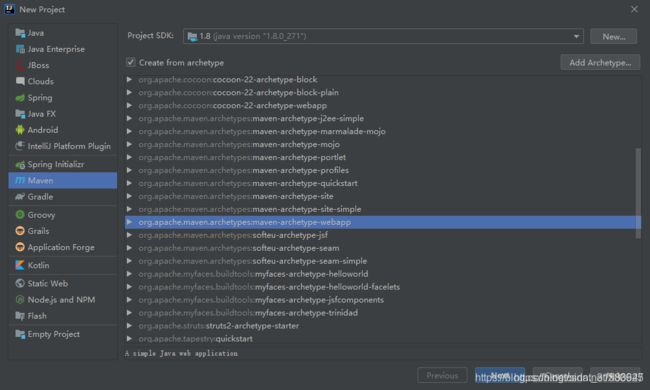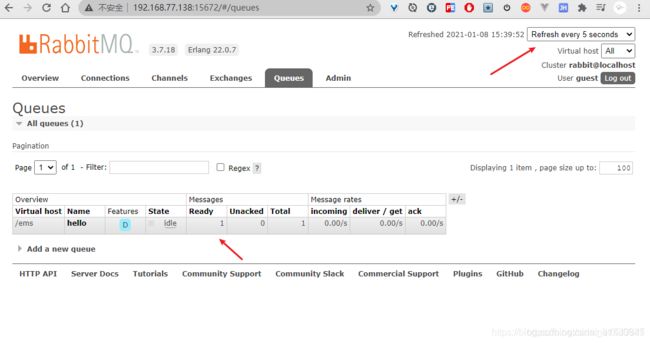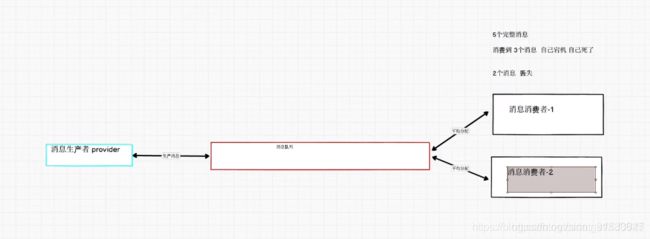第五章_Java 实现RabbitMQ
环境搭建
1、新建 java web 项目
2、改pom
com.rabbitmq
amqp-client
5.7.2
同时去掉测试依赖的
第一种模型(直连)
这种使用的场景如:注册成功后,发送短信的场景或加积分场景
在上图的模型中,有以下概念:
- P:生产者,也就是要发送消息的程序
- C:消费者:消息的接受者,会一直等待消息到来
- queue:消息队列,图中红色部分。类似一个邮箱,可以缓存消息;生产者向其中投递消息,消费者从其中取出消息
前提:
- 创建好虚拟主机
- 创建好用户
- 虚拟主机与用户进行绑定
1. 开发生产者
public class Producer {
@Test
public void pro() throws IOException, TimeoutException {
//创建连接工厂
//创建连接mq的连接工厂对象
ConnectionFactory factory = new ConnectionFactory();
//设置连接rabbitmq主机
factory.setHost("192.168.77.138");
//设置端口号
factory.setPort(5672);
//设置访问虚拟主机的用户名和密码
factory.setUsername("ems");
factory.setPassword("123");
//设置连接那个虚拟主机
factory.setVirtualHost("/ems");
//获取连接对象
Connection connection = factory.newConnection();
//获取连接中通道
Channel channel = connection.createChannel();
//通道绑定对应消息队列
//参数1: 队列名称 如果队列不存在自动创建
//参数2: 用来定义队列特性是否要持久化 true 持久化队列 false 不持久化
//参数3: exclusive 是否独占队列,表示声明的当前队列只允许当前的连接所使用 true 独占队列 false 不独占
//参数4: autoDelete: 是否在消费完成后自动删除队列 true 自动删除 false 不自动删除
//参数5: 额外附加参数
channel.queueDeclare("hello", true, false, false, null);
//发布消息
//参数1: 交换机名称 参数2:队列名称 参数3:传递息额外设置(MessageProperties.PERSISTENT_TEXT_PLAIN 设置消息持久化) 参数4:消息的具体内容
channel.basicPublish("", "hello", MessageProperties.PERSISTENT_TEXT_PLAIN, "hello rabbitmq".getBytes());
//关闭连接
channel.close();
connection.close();
}
}生产消息到队列:
2. 开发消费者
消费者端不能使用单元测试,需要一直监听
同时不关闭连接消息通道与连接
public class Consumer {
public static void main(String[] args) throws IOException, TimeoutException {
//创建连接工厂
ConnectionFactory factory = new ConnectionFactory();
factory.setHost("192.168.77.138");
factory.setPort(5672);
factory.setVirtualHost("/ems");
factory.setUsername("ems");
factory.setPassword("123");
Connection connection = factory.newConnection();
//创建通道
Channel channel = connection.createChannel();
//通道绑定队列:与生产端一致
channel.queueDeclare("hello", true, false, false, null);
//获取消息
//参数1: 消费那个队列的消息 队列名称
//参数2: 开始消息的自动确认机制[只要消费就从队列删除消息]
//参数3: 消费时的回调接口
channel.basicConsume("hello", true, new DefaultConsumer(channel) {
@Override
public void handleDelivery(String consumerTag, Envelope envelope, AMQP.BasicProperties properties, byte[] body) throws IOException {
System.out.println("取出消息:===>" + new String(body));
}
});
//消费端连接与同道不用关闭,一直处于监听状态
}
}3. API参数的说明
注意:生产方队列的声明与消费方队列的声明要一致
channel.queueDeclare("hello",true,false,false,null);
# '参数1': 用来声明通道对应的队列 [ 如果不存在队列,会自动创建]
# '参数2': 用来指定是否持久化队列 [D: 指定后 rabbitmq 重启后不会消失 ]
# '参数3': 用来指定是否独占队列 [ 只允许当特定的连接]
# '参数4': 用来指定是否自动删除队列 [A:消息方消费完成后,队列自动删除]
# '参数5': 对队列的额外配置第二种模型(work queue)
Work queues,也被称为(Task queues),任务模型。当消息处理比较耗时的时候,可能生产消息的速度会远远大于消息的消费速度。长此以往,消息就会堆积越来越多,无法及时处理。此时就可以使用 work 模型:让多个消费者绑定到一个队列,共同消费队列中的消息。队列中的消息一旦消费,就会消失,因此任务是不会被重复执行的。
角色:
- P:生产者:任务的发布者
- C1:消费者-1,领取任务并且完成任务,假设完成速度较慢
- C2:消费者-2:领取任务并完成任务,假设完成速度快
1. 开发生产者
public class Producer {
@Test
public void pro() throws IOException {
//获取连接
Connection connection = RabbitMQUtils.getConnection();
//创建通道
Channel channel = connection.createChannel();
//绑定队列
channel.queueDeclare("work", true, false, false, null);
//发送消息
for (int i = 1; i <= 20; i++) {
channel.basicPublish("", "work", null, (i + "号消息").getBytes());
}
//关闭连接
RabbitMQUtils.closeConnection(channel, connection);
}
}2.开发消费者-1
public class Consumer1 {
public static void main(String[] args) throws IOException {
//获取连接
Connection connection = RabbitMQUtils.getConnection();
//创建通道
final Channel channel = connection.createChannel();
//绑定队列
channel.queueDeclare("work", true, false, false, null);
channel.basicConsume("work", true, new DefaultConsumer(channel) {
@Override
public void handleDelivery(String consumerTag, Envelope envelope, AMQP.BasicProperties properties, byte[] body) throws IOException {
try {
//处理消息比较慢 2秒处理一个消息
Thread.sleep(2000);
} catch (InterruptedException e) {
e.printStackTrace();
}
System.out.println("消费者1号:==>消费" + new String(body));
}
});
}
}3.开发消费者-2
public class Consumer2 {
public static void main(String[] args) throws IOException {
//获取连接
Connection connection = RabbitMQUtils.getConnection();
//创建通道
final Channel channel = connection.createChannel();
//绑定队列
channel.queueDeclare("work", true, false, false, null);
channel.basicConsume("work", true, new DefaultConsumer(channel) {
@Override
public void handleDelivery(String consumerTag, Envelope envelope, AMQP.BasicProperties properties, byte[] body) throws IOException {
System.out.println("消费者2号:==>消费" + new String(body));
}
});
}
}
4.测试结果
总结: 默认情况下,RabbitMQ将按顺序将每个消息发送给下一个使用者。平均而言,每个消费者都会收到相同数量的消息。这种分发消息的方式称为循环。
5.消息自动确认机制
如果想要实现消费快的多消费,消费慢的少消费,就需要对rabbitmq的消息确认机制进行配置
两点:
-
设置通道一次只能消费一个消息
-
关闭消息的自动确认,开启手动确认消息
消费方:
//步骤一:一次只接受一条未确认的消息
channel.basicQos(1);
//步骤二:[参数2:关闭自动确认消费]
channel.basicConsume("work", true, new DefaultConsumer(channel) {
@Override
public void handleDelivery(String consumerTag, Envelope envelope, AMQP.BasicProperties properties, byte[] body) throws IOException {
System.out.println("消费者2号:==>消费" + new String(body));
//消费完成后,手动确认消息 [ 参数1:确认标识,参数2:是否一次确认多条消息]
channel.basicAck(envelope.getDeliveryTag(), false);
}
});注意:消费方都需要进行手动确认,否则队列中不会确认删除
生产方:
//一次只发送一条消息
channel.basicQos(1);测试:
消费者1号消费一条消息,2s后确认消息,消费者2号消费一条消息,手动确认,消息从队列删除,继续从队列取得一条进行消费,直到队列不存在消息
第三种模型(fanout)
中文翻译:fanout 扇出 ,也称为广播
在广播模式下,消息发送流程是这样的:
- 可以有多个消费者
- 每个消费者有自己的queue(队列)
- 每个队列都要绑定到Exchange(交换机)
- 生产者发送的消息,只能发送到交换机,交换机来决定要发给哪个队列,生产者无法决定。
- 交换机把消息发送给绑定过的所有队列
- 队列的消费者都能拿到消息。实现一条消息被多个消费者消费
1. 开发生产者
广播 :一条消息多个消费者同时消费
public class Producer {
@Test
public void pro() throws IOException {
//获取连接
Connection connection = RabbitMQUtils.getConnection();
Channel channel = connection.createChannel();
//声明交换机 [ 参数一:交换机名字,参数2:交换机类型:fanout(广播模式) 固定]
channel.exchangeDeclare("register", "fanout");
//发布消息[参数1:交换机名字,参数2:路由,参数3:消息持久化,参数4:消息内容]
channel.basicPublish("register", "", null, "fanout...".getBytes());
//关闭
RabbitMQUtils.closeConnection(channel, connection);
}
}2. 开发消费者-1
public class Consumer1 {
public static void main(String[] args) throws IOException {
//获取连接
Connection connection = RabbitMQUtils.getConnection();
Channel channel = connection.createChannel();
//声明交换机
channel.exchangeDeclare("register", "fanout");
//创建临时队列
String queue = channel.queueDeclare().getQueue();
//[绑定]=>临时队列和交换机 [参数1:临时队列,参数2:交换机,参数3:路由]
channel.queueBind(queue, "register", "");
//消费消息
channel.basicConsume(queue, true, new DefaultConsumer(channel) {
@Override
public void handleDelivery(String consumerTag, Envelope envelope, AMQP.BasicProperties properties, byte[] body) throws IOException {
System.out.println("消费者1号:==>" + new String(body));
}
});
}
}3. 开发消费者-2
public class Consumer2 {
public static void main(String[] args) throws IOException {
//获取连接
Connection connection = RabbitMQUtils.getConnection();
Channel channel = connection.createChannel();
//声明交换机
channel.exchangeDeclare("register", "fanout");
//创建临时队列
String queue = channel.queueDeclare().getQueue();
//绑定临时队列和交换机 [参数1:临时队列,参数2:交换机,参数3:路由]
channel.queueBind(queue, "register", "");
//消费消息
channel.basicConsume(queue, true, new DefaultConsumer(channel) {
@Override
public void handleDelivery(String consumerTag, Envelope envelope, AMQP.BasicProperties properties, byte[] body) throws IOException {
System.out.println("消费者2号:==>" + new String(body));
}
});
}
}4.开发消费者-3
public class Consumer3 {
public static void main(String[] args) throws IOException {
//获取连接
Connection connection = RabbitMQUtils.getConnection();
Channel channel = connection.createChannel();
//声明交换机
channel.exchangeDeclare("register", "fanout");
//创建临时队列
String queue = channel.queueDeclare().getQueue();
//绑定临时队列和交换机 [参数1:临时队列,参数2:交换机,参数3:路由]
channel.queueBind(queue, "register", "");
//消费消息
channel.basicConsume(queue, true, new DefaultConsumer(channel) {
@Override
public void handleDelivery(String consumerTag, Envelope envelope, AMQP.BasicProperties properties, byte[] body) throws IOException {
System.out.println("消费者3号:==>" + new String(body));
}
});
}
}5. 测试结果
启动消费者,再启动生产者往交换机发送消息,三个消费者同时接收到消息
第四种模型(Routing)
Routing 之订阅模型-Direct(直连)
在Fanout模式中,一条消息,会被所有订阅的队列都消费。但是,在某些场景下,我们希望不同的消息被不同的队列消费。这时就要用到Direct类型的Exchange
在Direct模型中,流程如下:
- 队列与交换机的绑定,不能是任意绑定了,而是要指定一个 RoutingKey(路由key)
- 消息的发送方在向 Exchange发送消息时,也必须指定消息的 RoutingKey
- Exchange不再把消息交给每一个绑定的队列,而是根据消息的 RoutingKey 进行判断,只有队列的Routingkey与消息的 Routing key 完全一致,才会接收到消息
图解:
- P:生产者,向Exchange发送消息,发送消息时,会指定一个routing key
- X:Exchange(交换机),接收生产者的消息,然后把消息递交给 与 routing key 完全匹配的队列
- C1:消费者,其所在队列指定了需要 routing key 为 error 的消息
- C2:消费者,其所在队列指定了需要 routing key 为 info、error、warning 的消息
1. 开发生产者
public class Producer {
@Test
public void pro() throws IOException {
//获取连接
Connection connection = RabbitMQUtils.getConnection();
//创建通道
Channel channel = connection.createChannel();
//声明交换机[参数1:交换机名字, 参数2:交换机类型,direct路由模式]=>基于指令的 Routing key 转发
channel.exchangeDeclare("logs_direct", "direct");
//发布的路由名称==>根据路由key的不同发送到不同的绑定队列中
String key = "error";
//发布消息[参数1:交换机名字,参数2:路由名字,参数3:消息内容]
channel.basicPublish("logs_direct", key, null, ("发送给指定路由" + key + "的消息").getBytes());
//关闭连接
RabbitMQUtils.closeConnection(channel, connection);
}
}2.开发消费者-1
public class Consumer1 {
public static void main(String[] args) throws IOException {
//获取连接
Connection connection = RabbitMQUtils.getConnection();
//创建通道
Channel channel = connection.createChannel();
//声明交换机[参数1:交换机名字, 参数2:交换机类型,direct路由模式]
channel.exchangeDeclare("logs_direct", "direct");
//创建临时队列
String queue = channel.queueDeclare().getQueue();
//绑定临时队列与交换机并设置指定路由名称
channel.queueBind(queue, "logs_direct", "info");
channel.queueBind(queue, "logs_direct", "error");
channel.queueBind(queue, "logs_direct", "warn");
//消费消息
channel.basicConsume(queue, true, new DefaultConsumer(channel) {
@Override
public void handleDelivery(String consumerTag, Envelope envelope, AMQP.BasicProperties properties, byte[] body) throws IOException {
System.out.println("消费者1号:==>" + new String(body));
}
});
}
}3.开发消费者-2
public class Consumer2 {
public static void main(String[] args) throws IOException {
//获取连接
Connection connection = RabbitMQUtils.getConnection();
//创建通道
Channel channel = connection.createChannel();
//声明交换机[参数1:交换机名字, 参数2:交换机类型,direct路由模式]
channel.exchangeDeclare("logs_direct", "direct");
//创建临时队列
String queue = channel.queueDeclare().getQueue();
//绑定临时队列与交换机并设置指定路由名称
channel.queueBind(queue, "logs_direct", "error");
//消费消息
channel.basicConsume(queue, true, new DefaultConsumer(channel) {
@Override
public void handleDelivery(String consumerTag, Envelope envelope, AMQP.BasicProperties properties, byte[] body) throws IOException {
System.out.println("消费者2号:==>" + new String(body));
}
});
}
}4.测试
测试生产者发送Route key为error的消息时
测试生产者发送Route key为info的消息时
第五种模型(Topic)
Routing 之订阅模型-Topic
Topic 类型的 Exchange 与 Direct 相比,都是可以根据 RoutingKey 把消息路由到不同的队列
只不过Topic类型 Exchange 可以让队列在绑定Routing key 的时候使用通配符!
这种模型 Routingkey 一般都是由一个或多个单词组成,多个单词之间以”.”分割,例如: item.insert
# 统配符
*(star) can substitute for exactly one word. 匹配不多不少恰好1个词
#(hash) can substitute for zero or more words. 匹配一个或多个词
# 如:
audit.# 匹配audit.irs.corporate或者 audit.irs 等
audit.* 只能匹配 audit.irs1.开发生产者
public class Producer {
@Test
public void pro() throws IOException {
//创建连接
Connection connection = RabbitMQUtils.getConnection();
Channel channel = connection.createChannel();
//声明交换机[交换机名字+交换机类型]
channel.exchangeDeclare("topics", "topic");
//发布消息==>使用动态路由(通配符方式)
String key = "user.update"; //指定发布的路由key
channel.basicPublish("topics", key, null, ("发送消息给指定的路由key" + key).getBytes());
//关闭连接
RabbitMQUtils.closeConnection(channel, connection);
}
}2.开发消费者-1
Routing Key中使用*通配符方式
public class Consumer1 {
public static void main(String[] args) throws IOException {
//创建连接
Connection connection = RabbitMQUtils.getConnection();
Channel channel = connection.createChannel();
//声明交换机
channel.exchangeDeclare("topics", "topic");
//声明临时队列
String queue = channel.queueDeclare().getQueue();
//绑定临时队列与交换机并设置获取交换机中动态路由
String key = "user.*";//使用通配符指定路由key
channel.queueBind(queue, "topics", key);
//消费消息
channel.basicConsume(queue, true, new DefaultConsumer(channel) {
@Override
public void handleDelivery(String consumerTag, Envelope envelope, AMQP.BasicProperties properties, byte[] body) throws IOException {
System.out.println("消费者1号:===>" + new String(body));
}
});
}
}3.开发消费者-2
Routing Key中使用*通配符方式
public class Consumer2 {
public static void main(String[] args) throws IOException {
//创建连接
Connection connection = RabbitMQUtils.getConnection();
Channel channel = connection.createChannel();
//声明交换机
channel.exchangeDeclare("topics", "topic");
//声明临时队列
String queue = channel.queueDeclare().getQueue();
//绑定临时队列与交换机
String key = "user.#";//使用通配符指定路由key
channel.queueBind(queue, "topics", key);
//消费消息
channel.basicConsume(queue, true, new DefaultConsumer(channel) {
@Override
public void handleDelivery(String consumerTag, Envelope envelope, AMQP.BasicProperties properties, byte[] body) throws IOException {
System.out.println("消费者2号:===>" + new String(body));
}
});
}
}4.测试结果
生产者发送user.update时
两个消费者都可以消费消息
生产者发送user.update.to时
仅消费者2号可以消费消息




















